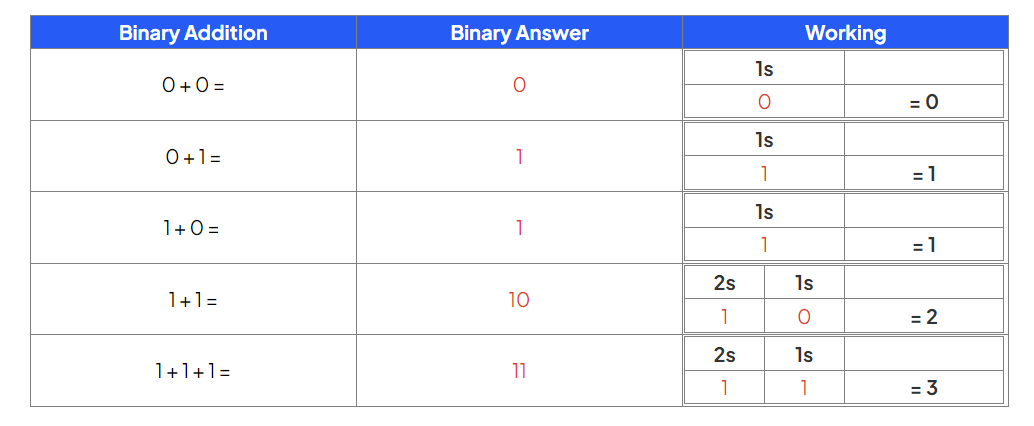Binary Addition (AQA GCSE Computer Science): Revision Note
Exam code: 8525
Binary Addition
What is binary addition?
Binary addition is the process of adding together up to three binary integers (up to and including 8 bits)
To be successful there are 5 golden rules to apply:

Like denary addition, start from the rightmost digit and move left
Carrying over occurs when the sum of a column is greater than 1, passing the excess to the next left column
Example 1
Add together the binary values 1001 and 0100

Starting from right to left, add the two binary values together applying the 5 golden rules
If your answer has 2 digits, place the rightmost digit in the column and carry the remaining digit to the next column on the left
In this example, start with 1+0, 1+0 = 1, so place a 1 in the column

Repeat until all columns have a value

The sum of adding together binary 1001 (9) and 0100 (4) is 1101 (13)
Examiner Tips and Tricks
Make sure any carried digits are clearly visible in your answer, there are marks available for working. Carries can be put above or below in the addition
Example 2
Add together the binary values 00011001 and 10000100

Starting from right to left, add the two binary values together applying the 5 golden rules
If your answer has 2 digits, place the rightmost digit in the column and carry the remaining digit to the next column on the left
In this example, start with 1+1, 1+1 = 10, so place a 0 in the column and carry the 1 to the next column

Repeat until all columns have a value

The sum of adding together binary 00011001 (25) and 10001001 (137) is 10100010 (162)
Example 3
Add together the binary values 00011011, 00010110 and 00100010

Starting from right to left, add the two binary values together applying the 5 golden rules
If your answer has 2 digits, place the rightmost digit in the column and carry the remaining digit to the next column on the left
In this example, start with 1+0+0, 1+0+0 = 1, so place a 1 in the column
In the second column we have 1+1+1, 1+1+1 = 11, so place 1 in that column and carry the other 1 to the next column

Repeat until all columns have a value

The sum of adding together binary 00011011 (27), 00010110 (22) and 00100010 (34) is 01010011 (83)
What is an overflow error?
An overflow error occurs when the result of a binary addition exceeds the available bits
For example, if you took binary 11111111 (255) and tried to add 00000001 (1) this would cause an overflow error as the result would need a 9th bit to represent the answer (256)


Unlock more, it's free!
Did this page help you?